Overview
The next thing I wanted to analyze with player development was which junior teams and leagues are best at developing players. Every year you see players get picked from a team like the London Knights, and most people think, yeah, that guy is probably gonna be good. Similarly, it is clear that certain teams/leagues have much better "support systems" for players, better weight rooms/S&C coaches, better/more video review time, and just a general focus on player development. Now obviously the best development league for any given player is different. You could have thrown me straight into the NCAA when I played, but I probably wouldn't have gotten much better because I never would have gotten ice time or training attention from the coaches because I would have been so much worse than the worst player to have ever played for that team. But still, I think there are generally better and worse teams/leagues for development, and that is what I wanted to test here.
My methodology for this was pretty similar to the one I described in my NHL draft and development article. I looked at player development, defined by me as the year over year change in league adjusted scoring. Again, I chose this metric because it is easiest with the data I have instead of doing month by month, or half year splits, and still gives me a somewhat large sample rather than looking at only players who spent their entire junior careers with one team. I then just took the average development of all players for every team, and used that as the team's development rating. There was no DevoX type adjustments for this, because it's incredibly hard to get an even expectation for all players across all junior leagues before they join, and across various different ages as well. The one thing I can think of, now, looking back on it, would have been to look at the players league adjusted scoring and age to try and predict how much they should score the following year, then use that as the new baseline for how well a team developed that player, but I'm not sure how effective that would be, but it would be an interesting thing for me to potentially look at in the future. Also, one minor issue I ran into was junior teams that relocated sometimes got listed as completely new organizations, so if a player played for Plymouth one year, then Flint the next, despite those being largely similar teams, I scraped all of those players like they played for two different teams. Though if teams simply rebranded, Cape Breton Screaming Eagles to just the Eagles, or something like that, I did keep them as one team.
Results
The first thing I looked at was which junior teams were best at developing players, broken down by league. I looked at the 4 major North American Junior leagues, and the top junior leagues from each of Sweden, Finland, and Russia. Now, first, the OHL:
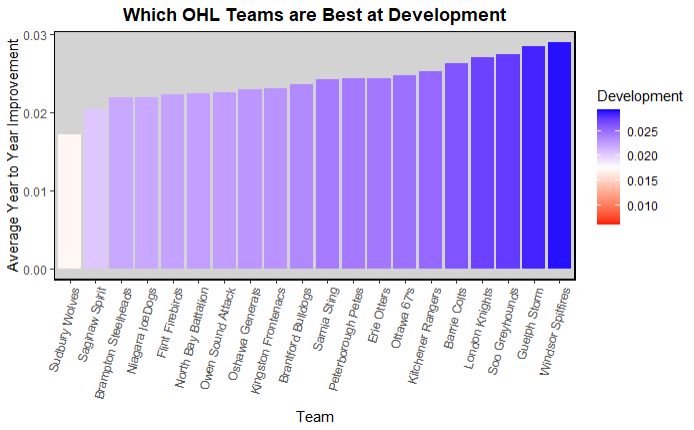
The top 3 were Windsor, Sudbury, and SOO, which surprised me to not see London up there considering how many players they put into the NHL. But they are still in 4th, and I think a lot of their success has been from drawing in big name talents to come play for them because of their history, so they get the already more developed kids out of the draft. They also do have some of the top facilities in the league, and seem to always have some of the top OHL prospects, many of whom they trade for already established top OHLers. So they don't get the credit for developing them in my model, even if they get to claim another NHLer for themselves. Another interesting note I saw was Kitchner still up there, mainly off of their recent performance and track record of development making up for many lost years early in my dataset. Also, most of the OHL teams were near the top of all junior leagues I looked at.
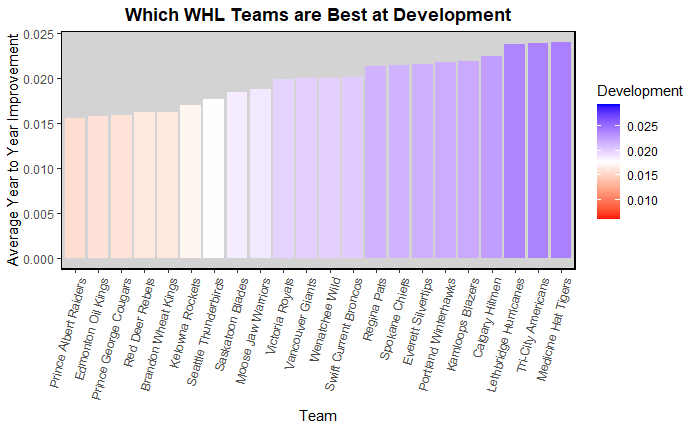
The WHL seems to be, nearly across the board, a "worse" league for development than the OHL. However, I would certainly not say that a player entering even the bottom WHL team in Prince Albert, has a significnatly lower chance at making the NHL than a player entering most OHL teams. Mainly because league strengths and development patterns swing over time, and it seems that recently the WHL has been having more and more players get drafted, and enter the NHL, and this is taking the average for all of these teams dating all the way back to 2000. If I tried looking at a smaller section of years, say since 2020, I would bet that a lot of WHL teams come out near the top, however, the sample sizes on that, using my methodolgy would be tiny. I did also find it incredibly interesting that PA was the worst WHL team, because I first started following juniors seriously during the 18-19 season when PA was an absolute wagon with Leason, Guhle, Weisblatt, Gregor, and Ian Scott, so I assumed they were always great.
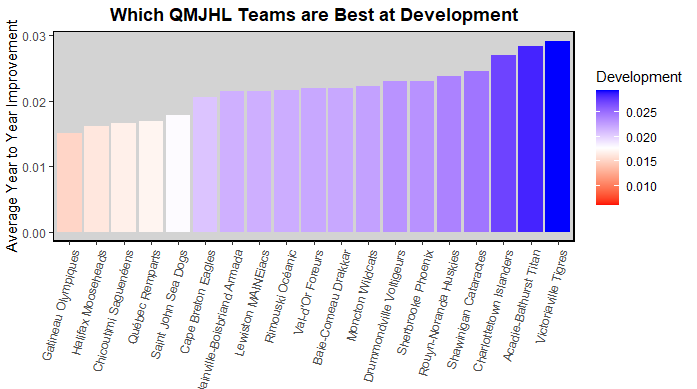
The Q was one of the most polarized leagues. Victoriaville was the best team in North America using my grading methodology, but Gatineau was the worst. Seeing Victoriaville, or really any Q teams that high surprised me, knowing the way the Q is now with an incredibly lackluster development track record over the past ~5 drafts. However, it is also the league I know the least about among the 4 North American junior leagues, so I can't really say if it's insane that Victoriaville is that high or not.
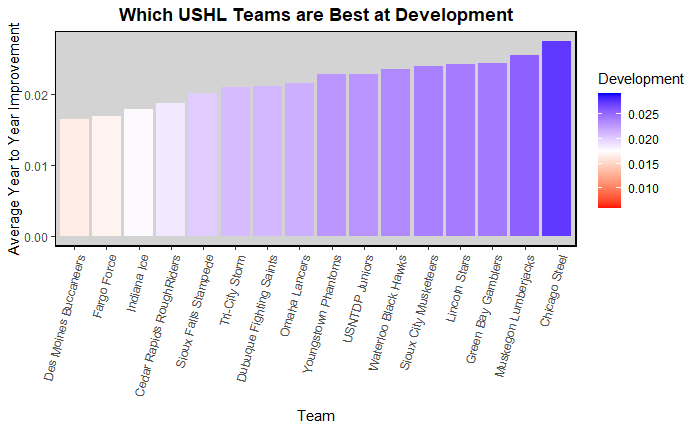
Finally, I looked at the USHL, which, I know was not nearly as strong as the CHL leagues for most of this time, however, I was not looking at league strength, but league development, which I think the USHL has always put as a major focus. In Canada a lot of the junior teams are run like businesses looking to succeed at all costs, while in the USHL, a lot of teams tend to view developing players into NCAA players as a success (secondary to winning the Clark Cup of course, but still a success), and will work with NCAA teams and scouts to draft and develop certain players. That being said, Chicago still absolutely destroys the rest of the league when it comes to development. I guess that isn't shocking, they put tons and tons of money into their S&C and development programs, second only to the NTDP I think, and they are generally getting players with longer runways before the NCAA, and lower starting points than the NTDP who only selects the already mostly developed players. They also give players the cance to progress up in the lineup in Chicago, vs in the NTDP where if you're a 4th line guy with the 17s, you're likely to still be a 4th line guy with the 18s.
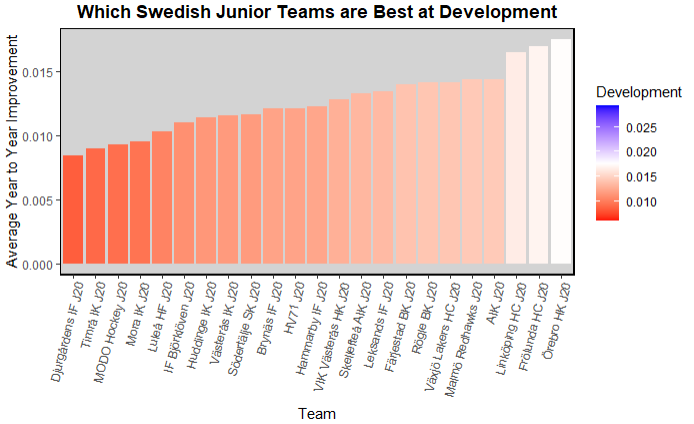
Looking at the Swedish teams, I was not particularly surprised to see those 3 at the top, and being the only junior programs competetive with North American teams. I don't know enough about the Swedish development system to know why those programs are the best, do tey habe the best coaches, best facilities, are in the best locations to attract top talent, I'm not sure. I do know that almost every time I see a top prospect out of the Swedish Junior system, they spent time in one of those 3 programs, so it does check out to my memory.
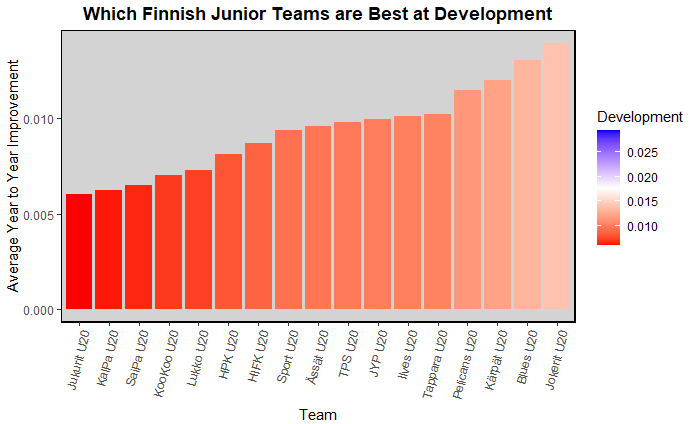
Similarly in Finland, Jokerit being at the top makes sense, there was a benefit to their mens team leaving to play in the KHL at the top of its strength. It drew in a bunch of the top Finnish talent I would assume, or because it already had so much of the top Finnish talent, they decided to leave for the KHL. Then similarly to Sweden, Karpat at the top makes sense, because I feel like I tend to see a lot of players coming through that system. But again, aside from Jokerit, I couldn't tell you enough about the Finnish system to tell you if these numbers make sense.
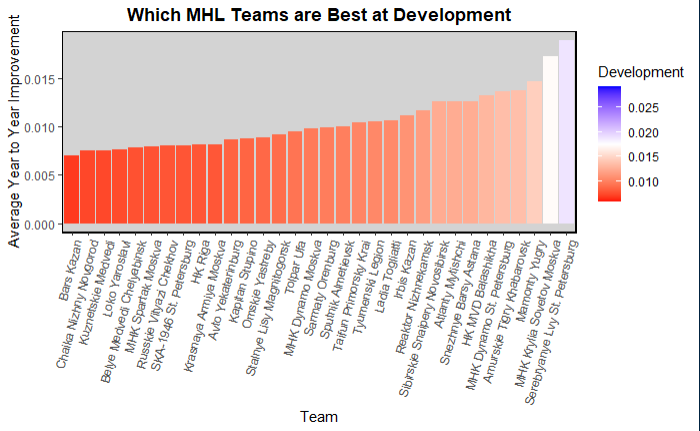
And finally for the MHL... Probably the biggest shit show of a notable junior league, the amount of new teams, and folding teams, and organizations with 2+ teams in the same league is just insane. They also have recently officially split into basically 2 seperate leagues with gold and silver divisions, though the massive divide between the Eastern and Western conferences within those divisions remains. This is a league where I couldn't even begin to tell you who I think would be best at development, but it absolutely does not shock me that the worst teams at development come from this league
I would also like to say that while the graphs make it appear as if there is a massive difference between the top and bottom teams because of the colors, there is actually only a difference of ~0.025 NHL points per game, which is basically 2 NHL points across a season. Which seems like almost nothing, but is equivalent to approximately 8 points over the course of a 68 game OHL season, or 11 points over the course of a 52 game MHL season, so not nothing in terms of those leagues scoring. Imagine if the average player on your team improved by 10 points per season while the average player on your rival improved by just under 20, not ideal.
It was interesting to see the North American dominance in these development metrics. It seems like North American prospects should be leaving European ones in the dust!!! But not so fast, clearly, European nations can develop players just as well, if not better because a nation like Finland is still competetive with the US and Canada on the international stage, and not all of their players just leave for North America the first second they can. I have two theories as to why European junior leagues all appear lower down in the development rankings than North American ones. First was that their league multipliers were lower, so if a player incresed by 10 OHL points, that would be a much greater jump in development than if a player increased by 10 J20-Nationell points. However, the USHL also has a lower league multiplier and it still competes in development rankings. The second, and more important thing is that players are not bound to one league. If a player jumps by, say 15 J20-Nationell points instead of 10, which say in this example is the equivalent of 10 OHL points, all of a sudden that player is now playing in the Allsvenskan or SHL. And with my system, they would no longer count towards their junior teams development, even though they most likely did most of the work developing that player. So basically all of their top players who they develop the most get taken away from their development ranking in my model, because they made the jump to the pros.
I also looked at NCAA team development, on a seperate scale, because they are dealing with players at a different time in their careers. Most of them are 20+ and pretty close to physically developed, and are now looking to move on to a pro career, and have already been drafted, or passed over in the draft.

The number one thing that stood out to me when I saw this was RMU's dominance. They are Pittsburgh's college hockey team, so I grew up going to tons of their games, skating at their rink all the time, and I NEVER would have predicted that. I thought they would have been closer to Bently, in the negatives. Not to disrespect Derek Schooley and the work he does with that program, but I know how much of a struggle funding is at times, and that they had the program cut for a few years, despite recent successes. But aside from them, seeing all of the other lower tier AHA schools at the top shocked me as well. My guess would be they usually have older rosters with worse incoming freshmen, so freshmen will get 4th line minutes, maybe score a few points, then the next year see a jump in toi and scoring, then another the following year. Meanwhile at most top programs, players are usually highly touted coming in and play in the top 6 immediately then move out, or are stuck in the bottom 6 their whole time with the program just constantly getting jumped by the new crop of incoming NHL talents, so they never see the boost in production from an increase in ice time. Also seeing Denver and David Carle as the first/second (Mankato) high end program is not surprising, and really gives me hope for whichever team ends up eventually hiring him away from Denver.
The next thing I wanted to look at was which leagues were best at developing players, and at what times in their careers. Obviously a 16 year old playing in the SHL is incredible, and likely a sign of promising things to come, but a 20 year old playing in the USHL says the exact opposite. The overall league averages are next, followed by the same thing broken down by draft year.
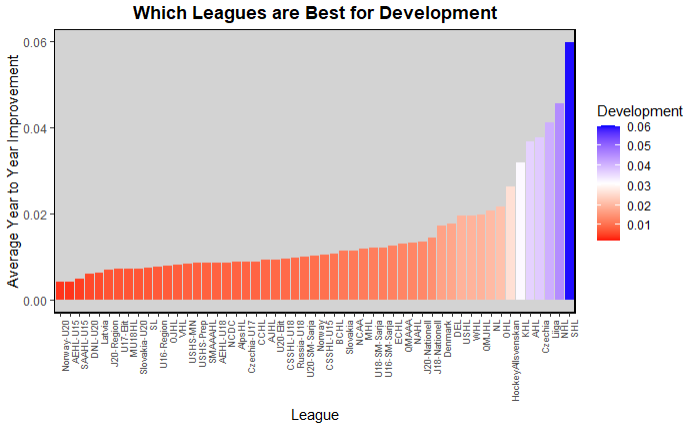
I don't think you could necessarily get much out of this graph in terms of my prospects should all be in x league or y league, because if they aren't ready for the SHL/NHL just playing in that league likely won't help them. They won't get ice time to actually develop, and will lose confidence and the trust of their coaches. But it is intereesting to see the pro leagues at the top with a MASSIVE jump to the SHL. Though I suppose it makes sense because a 10 point jump in any pro league will be far more impactful on league adjusted points than a 10 point jump in juniors. Even if the jump in league scoring is lower at 21-23 in the pros, that still outweights the larger jumps in scoring made in juniors because each of those points is far more "valuable".
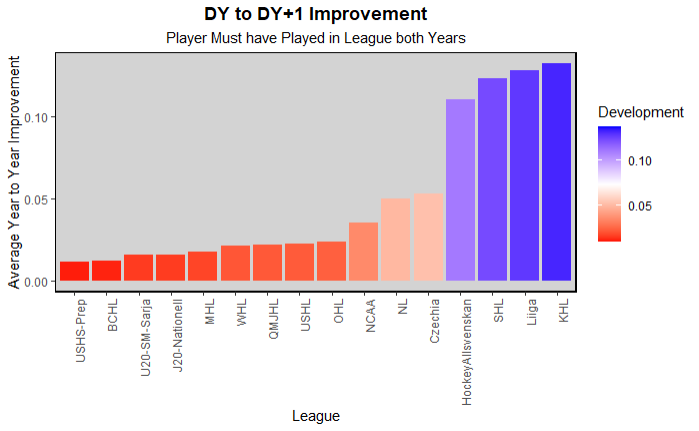
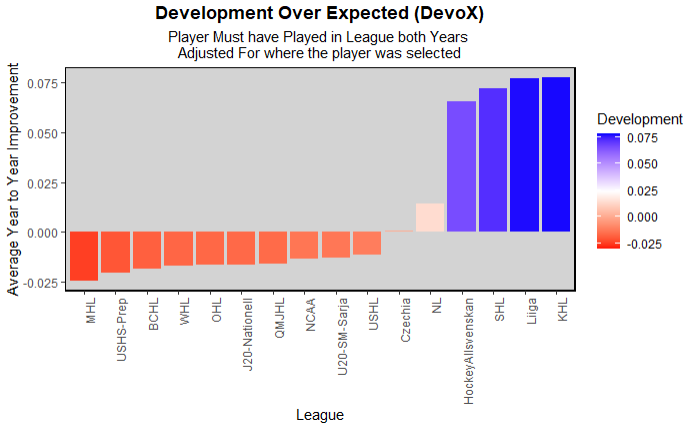
Looking at specific years, starting with DY to DY+1 development, we see a similar trend that pro leagues reign supreme. Both in terms of raw development, and DevoX, the top 6 leagues are all pro leagues. I suppose this doesn't shock me because most players playing pro in their DY barely get any ice time, and the expectation is that they earn that ice time within the next season or two and you see that big jump in production. This also supports my theory that pro leagues are still undervalued in DY NHLe models, because of the ice time factor, at least for player's floors. I think they tend to overrate the high end players who do get that ice time at an early age for a variety of reasons. Comparatively, 99% of the players drafted out of the CHL are already stars or at least impact players getting basically as much ice time as they can possibly get, so you don't see that jump because it either already happened, will happen when they leave the league, or will simply never happen. They are usually already scoring near the top of the league, and it is incredibly hard to score more than 2 PPG, no matter how much better than the competition you are.
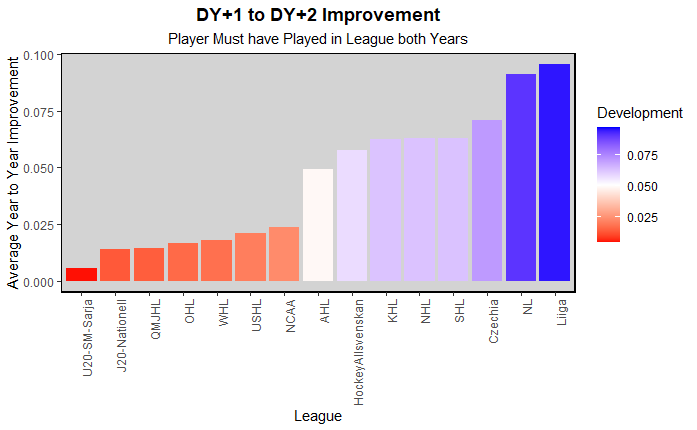
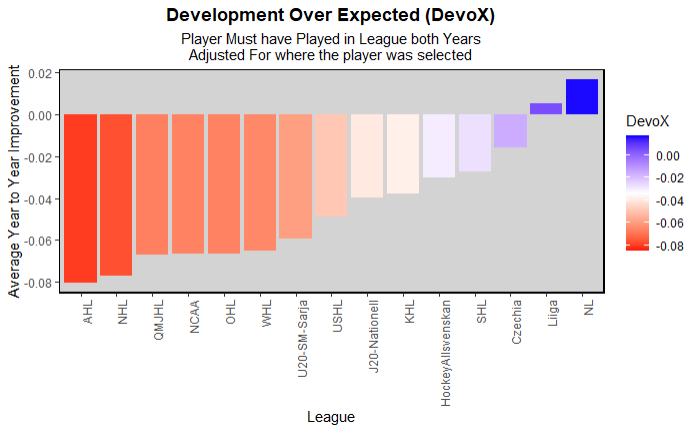
You see a similar trend with development from a players DY+1 to their DY+2 depending on which league they're in, but the interesting bit comes with DevoX. There is that massive drop in AHL and NHL rankings, which I have two things to say about. First, that is certainly some selection bias, that only the best players are able to play in either of those leagues in their DY+1 and DY+2. And in the AHL's case, most of the players good enough to play in the A in their DY+1 are expected to play in the NHL in their DY+2, so the only remaining players are those who developed worse than expected. The second thing this tells me is that the NHL is not a developmental league. Yes, coaches and organizations want you to get better, but they're not going to take time out of their lives that are dedicated to winning hockey games, to develop a player for the future. There is also the very unproven theory that I have, and have shared a few times online, that a lot of players go high in the draft, and play early because they are more physically mature than the rest of their age cohort. Then when everyone else catches up physically, they loose their edge and tend to stall out.
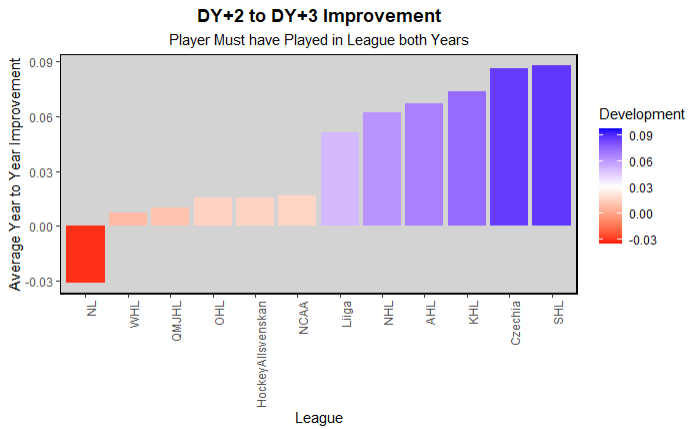
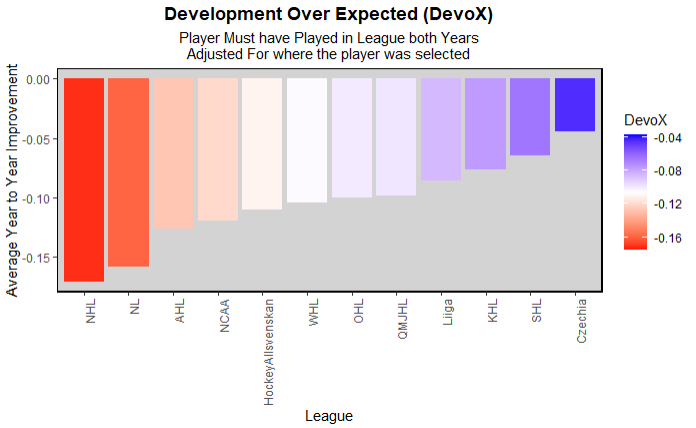
Once again, DY+2 to DY+3 shows similar trends that pro leagues are better at development in terms of raw numbers, but the NHL still isn't great at development relative to expectations. I also have a theory that the model I made to set those expectations expects too much development year over year from top picks, who usually come into the draft process pretty far along in their development, but also the "expectation" for top picks is that they will be impact, "core" players to teams, and living up to those expectations is not easy and does require a lot of development. The most interesting thing to me from that chart however, is that every single league has a negative DevoX. How is that possible you may ask. Because the expectation is that players don't remain in the same league from their DY to DY+1, or DY+2 to DY+3, or so on, until they reach the NHL. The expectation is that a player is consistently climbing leagues, get drafted from the USHL, make the jump to the NCAA in your DY+1, spend a year or two there until you dominate, the make the jump to the AHL, repeat the process then make the jump to the NHL. Because that interested me so much, I next wanted to look at a few of those common paths (AHL -> NHL, USHL -> NCAA, MHL -> KHL, and whatnot) to see how well players developed along those paths.
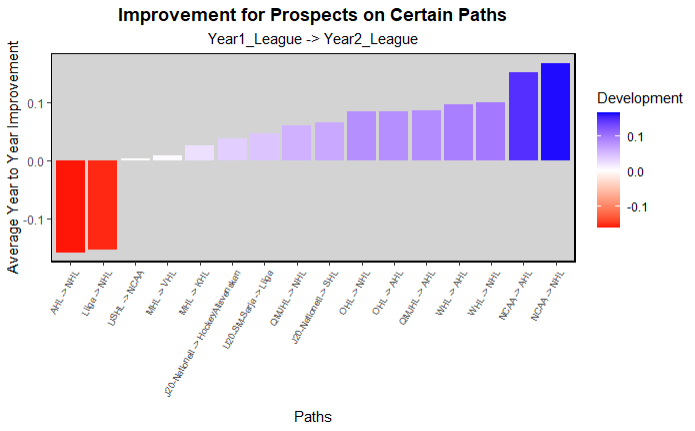
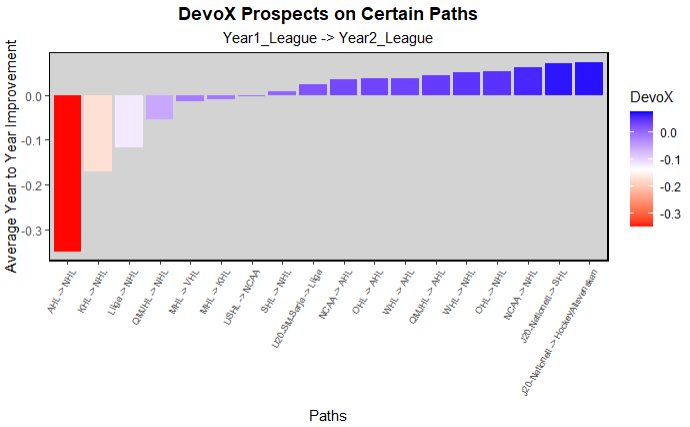
For this test, I only looked at certain, common paths that I could think of off the top of my head. I was pleased to see that most of them had a positive DevoX across the board, because unfortunately, the sample size of players that made the jump from the AHL to the NHL between their DY+2 and DY+3 seasons exactly is quite small. Also, seeing most of the paths to the NHL being at the bottom doesn't shock me. It is the hardest league in the world, so young players will absolutely have to take some time to adjust to the skill and size and speed and strength of the NHL more than similar players in their cohort who only have to adjust to SHL skill and strength or whatnot. I was largely pleased with the results of this analysis looking at development across various leagues. The team ones appeared a bit more iffy, though there was a lot smaller sample size with those, and you run into similar issues as when looking at NHL team development, but even worse. Junior teams are constantly under new management, not only can coaches/GMs be fired for being bad, they can also be poached for being too good at their jobs and all of a sudden a team has a whole new front office and development staff and ideology.
Also since I made the league by league graphs looking at development and the number of players, I figured I could post them here. I already did all of my analysis above, but here are some additional graphs:




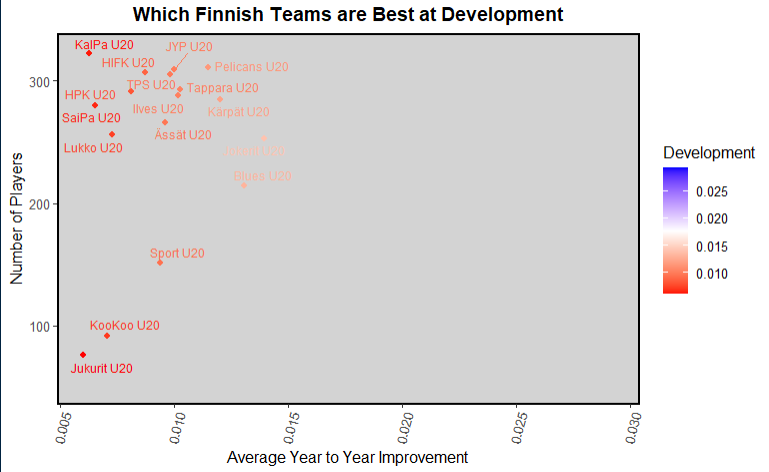
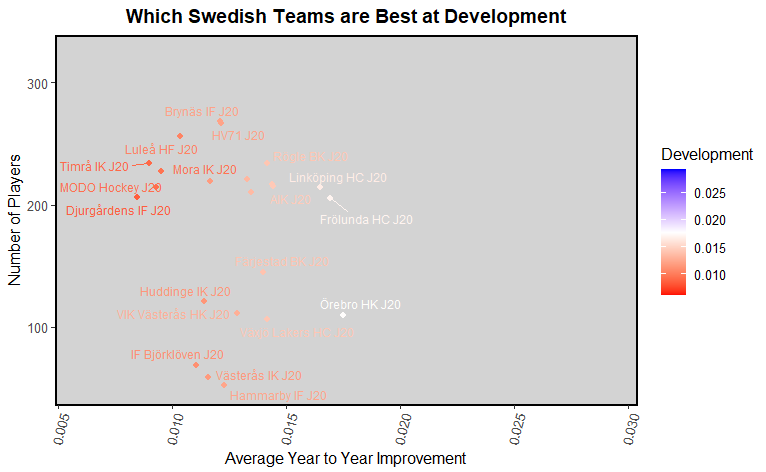
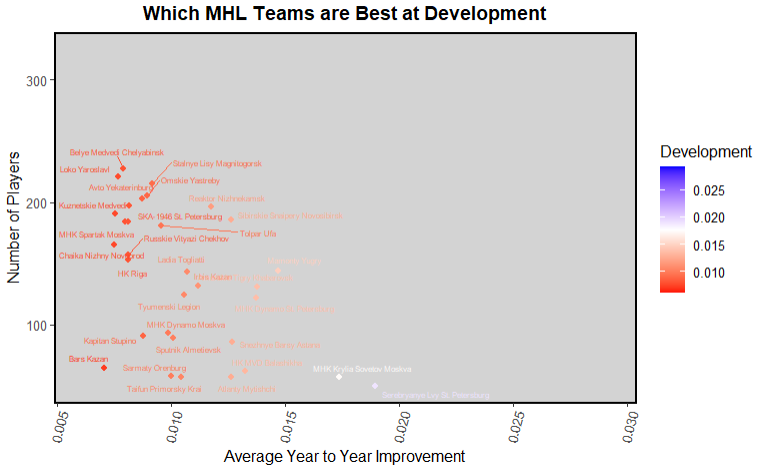
Data
Once again, this is one of many projects where I got basically all of the data from eliteprospects. I basically only used points and leagues from EP to evaluate players each season.